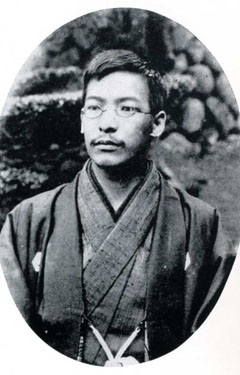- Kambara Ariake
Infobox Writer
name = Ariake Kambara

caption = Kambara Ariake
birthdate = birth date|1876|3|15|df=y
birthplace =Tokyo ,Japan
deathdate = death date and age|1952|2|3|1876|3|15|df=y
deathplace = Kamakura,Japan
occupation = Novelist, poet , translator
genre = sonnets
movement =symbolist poetry .
notableworks =
influences = Byron, Heine,John Keats , Rossetti.
influenced =
footnotes =nihongo|Kambara Ariake|蒲原有明| (
15 March 1876 –3 February 1952 ) was thepen-name of aJapanese poet andnovelist active in Taishō andShowa period Japan .Early life
Ariake was born in
Tokyo . His father, an ex"-samurai " fromHigo province , was a close associate ofEto Shimpei and active in theMeiji Restoration . He moved to Tokyo together withOki Takato and his mistress, leaving his wife back in Higo. Ariake's real name was Kambara Hayao. He was so sickly as an infant that his parents waited for a full year to officially register his name with the local government.Literary career
While still at middle school, he developed an interest in the works of Byron and Heine, and began writing poetry in a similar style. In 1894, he started a
literary journal called "Ochibo Zoshi" ("Gleaners’Notes") together withHayashida Shuncho andYamagishi Kayo , in which he serialized his first novel, nihongo|"Autumn Mountain Village"|秋の山ざと|Aki no Yamazato. He escapedmilitary conscription during theFirst Sino-Japanese War as he failed the physical examination.In 1898, he won first prize in a
Yomiuri Shimbun contest with his second novel nihongo|"Great Mercy"|大慈悲|Daijihi, which was highly praised by one of the judges,Ozaki Koyo . However, Ariake gave up prose and decided to concentrate only on poetry for the rest of his literary career.His first collection, "nihongo|"Young Leaves"|草わかば|Kusawakaba, was published in 1902, and borrowed themes from the ancient Japanese chronicles "
Kojiki " and "Fudoki ." However, the style of his works exhibited influence from western poets, such asJohn Keats andDante Gabriel Rossetti . He followed with a second collection of lyrical poetry called "Dokugen Aika" in 1903.Ariake served as the manager of a popular writer's salon called "Ryudokai", which was started in November 1904, by art critic
Iwamura Toru at a French restaurant called Ryudoken in Azabu, Tokyo. Ariake and Iwamura were friends, and Ariake made contact with numerous people in the contemporary literary work, includingDoppo Kunikida ,Katai Tayama ,Shimazaki Toson ,Masamune Hakucho , through his job as manager of the Ryudoken.In his fourth anthology, nihongo|"Ariake's Collection"|有明詩集|Ariaki Shu, in 1922, he introduced the 14-line
sonnet , which was previously seldom used in conventional Japanese modern poetry. Its publication gained him a reputation as a leading figure in Japanesesymbolist poetry . However, this came at a time when the literary world was gravitating rapidly towardsfree verse , and as Ariake refused to adapt to the new trends, he gradually withdrew from literary circles.In 1947 he published of his autobiographical novel, nihongo|"Dreams Call On"|夢は呼び交わす|Yume wa yobi kawasu, which was the final poetic work of his career, although he continued to work on translations of European poets as well as literary criticism.
In 1948, he was inducted into the
Japan Art Academy .Ariake moved from Tokyo to Kamakura,
Kanagawa prefecture in 1919, but was forced to relocate to Shizuoka cityShizuoka prefecture after his house collapsed during theGreat Kantō earthquake of 1923. He returned to Kamakura in 1945, after his house was burned down by the firebombing of Shizuoka during thePacific War . He continued to live in Kamakura until his death in 1952 of acutepneumonia at the age of 76.From 1945-1946, the Nobel Prize-winning
Kawabata Yasunari was a house-guest at Ariake's house in Kamakura.Ariake's grave is located at the temple of Kenso-ji in Moto-Azabu, Tokyo.
ee also
*
Japanese literature
*List of Japanese authors External links
* [http://www.aozora.gr.jp/index_pages/person1055.html e-text of Ariake's works] at
Aozora Bunko (Japanese site)
* [http://www.city.kamakura.kanagawa.jp/english/bunjin/kambara_e.htm Literary Figures of Kamakura]References
* Kambara, Ariake. "Ariake: Poems of Love and Longing by the Women Courtiers of Ancient Japan". Chronicle Books (2000). ISBN 0811828131
* Tu Kuo-ch'ing. "Li Chin-fa and Kambara Ariake: The First Symbolist Poets in China and Japan". Fung Ping Shan Library (1982). ISBN: B000H5PAZ8
Wikimedia Foundation. 2010.
